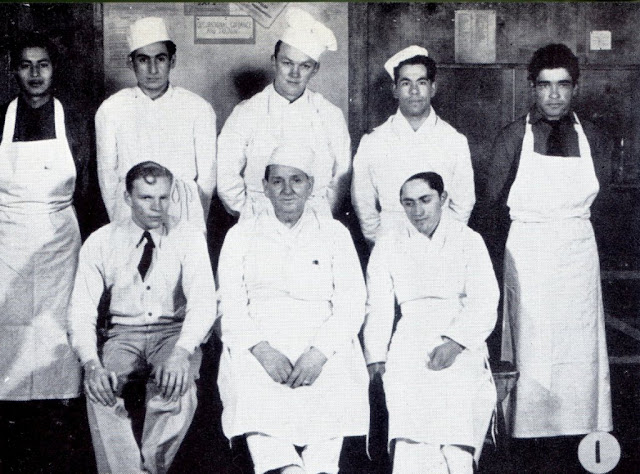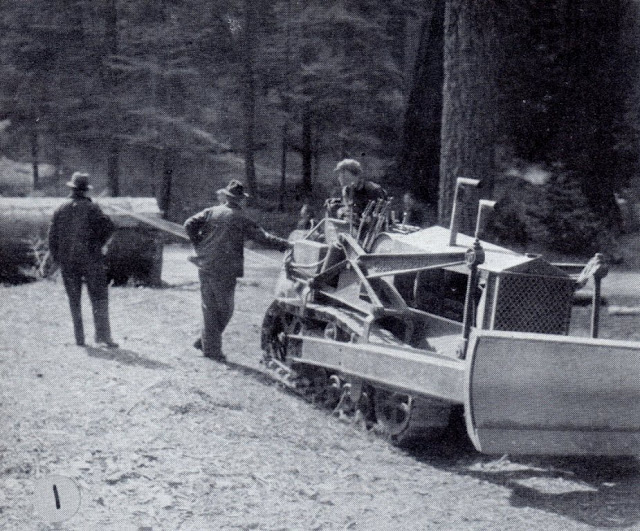All photos and information below (unless otherwise noted) are from: Civilian Conservation Corps, Fresno District, Ninth Corps Area, Official Annual, 1938.
Above: Part of CCC Company 942, Camp YNP-6, "Camp Cascades," Yosemite National Park, California, ca. 1938. The Living New Deal has many web pages detailing the CCC's work at Yosemite National Park, for example, "Trail Improvement and Restoration - Yosemite National Park CA."
Above: Members of Camp Cascades enjoying music recreation.

Above: Camp Cascades' cooks and K.P.'s. "K.P." is an army term for Kitchen Police - essentially, the folks that ensure everything in the camp cafeteria is clean and running smoothly. K.P. assignment is often on a rotational basis, whereas cooking might have been a more permanent job, at least for those with culinary skill and interest.

Above: The Camp Cascades' canteen. Another term used by the military, a "canteen" was a camp's general store.

Above: Camp Cascades in "retreat formation." This is a daily, end-of-day formation for the lowering of the flag.

Above: One of the commanding officers of Camp Cascades, First Lieutenant Axel Boldt of the U.S. Army. Boldt was born in Denmark in 1894, served in World War II, achieved the rank of major, and died in 1959 in Fresno County (see his Find a Grave web page here).

Above: One of Camp Cascades' junior officers, First Lieutenant Frank Clark, U.S. Army. Due to the common nature of his name, it was hard to find any additional information on Clark. I wonder what became of him.

Above: Major General George S. Simonds, commander of the Army and CCC Ninth Corps Area, where the Fresno District and Camp Cascades were located. Simonds died in San Francisco on November 1, 1938, not too long after the CCC Annual from which this photo was taken was published. (See Simonds Wikipedia entry here.)

Above: Robert Fechner, national director of the CCC. Over time, Fechner has acquired a reputation as a segregationist and racist, but the reality is probably more complicated and not quite as harsh. For example, the eventual segregation of CCC camps likely had less to do with his personal preference and more to do with other factors, such as racial complaints from nearby communities, U.S. army culture, and racial problems among some (but certainly not all) enrollees of integrated camps. Roy Wilkins, assistant secretary of the NAACP, said Fechner was "one of the fairest administrators of the New Deal. It was the experience of the NAACP that led to the belief that Mr. Fechner made as much effort as he could to have equality in the CCC. The trouble, however, was in the army control" ("See Advantage In FSA Control Over Two Youth Agencies," The Pittsburgh Courier, November 8, 1941, p. 24).

Above: The superintendent of Yosemite, 1937-1941. Merriam earned a degree in forestry in 1921, from the University of California (https://www.yosemite.ca.us/library/guardians_of_the_yosemite/superintendents.html).
Above: An assistant superintendent of Yosemite during the CCC time period. According to Wosky's Wikipedia page, he "worked for the National Park Service from the 1920s through the 1950s and designed a number of works that have been listed on the National Register of Historic Places. He was assigned to Yosemite National Park from 1928 to 1952, initially as the parks's resident architect, and later as its assistant superintendent. He later served as the superintendent at Crater Lake National Park and Hawaii Volcanoes National Park."

Above: The CCC warehouse for the Fresno District, in Fresno, California. Some of the food items you see here may have been sent to Camp Cascades.

Above: Trucks outside the Fresno warehouse. Perhaps one of these trucks was bound for Camp Cascades.

Above: A CCC boy from the Fresno District (not necessarily from Camp Cascades) pulling what appears to be a downed tree.

Above: CCC enrollees of the Fresno District working on what appears to be a canal, or a stream improvement or water diversion project.

Above: CCC boys in the Fresno District, uncovering what appears to be a cave or rock quarry, or perhaps victims of an avalanche, buried under several feet of snow.

Above: "Bridalveil Fall, Yosemite National Park," an oil painting by George Peter (1859-1950), created in 1940, possibly under the auspices of the WPA or as a commissioned work with the New Deal's Section of Fine Arts. Image courtesy of the General Services Administration.

Above: FDR was the driving force behind the creation of the CCC, and the CCC boys are often called Roosevelt's Tree Army or Roosevelt's Forest Army.
"The handling of our forests as a continuous, renewable resource means permanent employment and stability to our country life. The forests are also needed for mitigating extreme climatic fluctuations, holding the soil on the slopes, retaining the moisture in the ground, and controlling the equable flow of water in our streams. The forests are the 'lungs' of our land, purifying the air and giving fresh strength to our people. Truly, they make the country more livable."
--President Franklin Roosevelt, "Statement on being Awarded the Schlich Forestry Medal," January 29, 1935.







No comments:
Post a Comment